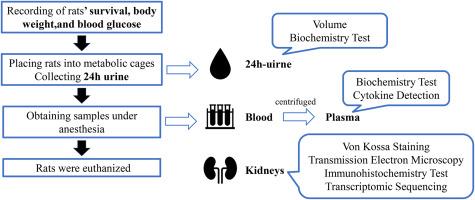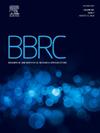Empagliflozin 可减少乙二醇氯化铵诱导的高草酸尿症大鼠肾脏草酸钙沉积。
IF 2.5
3区 生物学
Q3 BIOCHEMISTRY & MOLECULAR BIOLOGY
Biochemical and biophysical research communications
Pub Date : 2024-10-28
DOI:10.1016/j.bbrc.2024.150912
引用次数: 0
摘要
一项回顾性研究报告称,empagliflozin可降低糖尿病患者发生尿石症的风险。为了进一步研究empagliflozin的潜力,我们进行了一项动物实验,以确定empagliflozin是否能预防高草酸尿症大鼠肾结石的形成。通过在水中加入0.75%乙二醇和1%氯化铵,构建了高氧尿症大鼠模型。用不同浓度的恩格列净治疗大鼠,记录其体重和血糖数据。治疗 30 天后,我们采集了大鼠的 24 小时尿液、肾脏和血液样本。对尿液样本进行成分检测。血液样本用于成分检测和细胞因子检测。对肾脏样本进行von Kossa染色、透射电子显微镜、免疫组化和转录组测序分析。结果显示,经恩格列净治疗的高草酸尿症大鼠的肾晶体沉积和线粒体损伤、尿液中草酸盐的浓度和排泄量均显著降低。此外,血浆中的 VEGF、IL-2、IL-1β 和 MCP-1 水平也有所下降。免疫组化显示,经恩格列净治疗的高草酸尿症大鼠肾脏中KIM-1、MCP-1的表达明显减少。肾组织转录组测序结果显示,25个基因被下调,12个基因被上调。这些被调控的基因主要集中在脂肪酸代谢、胰岛素抵抗、肌肉收缩、胆汁分泌和甲状旁腺代谢等方面。我们的动物实验发现,empagliflozin能降低草酸盐在高草酸尿症大鼠尿液中的浓度和排泄量,抑制肾脏炎症,从而减轻非糖尿病状态下高草酸尿症大鼠的肾脏草酸钙沉积。本文章由计算机程序翻译,如有差异,请以英文原文为准。

Empagliflozin reduces renal calcium oxalate deposition in hyperoxaluria rats induced with ethylene glycol-ammonium chloride
A retrospective study reported that empagliflozin reduced the risk of urinary stone events in patients with diabetes mellitus. To further investigate empagliflozin's potential, we conducted an animal experiment to determine whether empagliflozin can prevent renal stone formation in hyperoxaluria rats. Hyperoxaluria rat models were constructed by administrating 0.75 % ethylene glycol and 1 % ammonium chloride in water. The empagliflozin-treated rats were gauged with empagliflozin at different concentrations, and their body weight and blood sugar data were recorded. After 30 days of treatment, we obtained 24-h urine, kidney, and blood samples. The urine samples were subjected to component detection. Blood samples were prepared for component detection and cytokines detection. Renal samples were subjected to von Kossa staining, transmission electron microscopy, immunohistochemistry, and transcriptome sequencing analysis. Results showed that in empagliflozin-treated hyperoxaluria rats, renal crystal deposition and mitochondria injury, urinary concentration, and excretion of oxalate were significantly decreased. Additionally, plasma levels of VEGF, IL-2, IL-1β, and MCP-1 were decreased. Immunohistochemistry showed that renal expression of KIM-1, MCP-1 was significantly decreased in empagliflozin-treated hyperoxaluria rats. Transcriptome sequencing of renal tissue represented that 25 genes were down-regulated while 12 were up-regulated in empagliflozin-treated hyperoxaluria rats. These regulated genes were mainly enriched in fatty acid metabolism, insulin resistance, muscle contraction, bile secretion, and parathyroid metabolism. Our animal experiments found that empagliflozin could reduce urinary concentration and excretion of oxalate and inhibit renal inflammation, then abating renal calcium oxalate deposition in hyperoxaluria rats in a non-diabetic state.
求助全文
通过发布文献求助,成功后即可免费获取论文全文。
去求助
来源期刊
CiteScore
6.10
自引率
0.00%
发文量
1400
审稿时长
14 days
期刊介绍:
Biochemical and Biophysical Research Communications is the premier international journal devoted to the very rapid dissemination of timely and significant experimental results in diverse fields of biological research. The development of the "Breakthroughs and Views" section brings the minireview format to the journal, and issues often contain collections of special interest manuscripts. BBRC is published weekly (52 issues/year).Research Areas now include: Biochemistry; biophysics; cell biology; developmental biology; immunology
; molecular biology; neurobiology; plant biology and proteomics

 求助内容:
求助内容: 应助结果提醒方式:
应助结果提醒方式:


